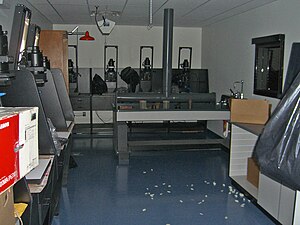

A darkroom is used to process photographic film, make prints and carry out other associated tasks. It is a room that can be made completely dark to allow the processing of light-sensitive photographic materials, including film and photographic paper. Various equipment is used in the darkroom, including an enlarger, baths containing chemicals, and running water.
Darkrooms have been used since the inception of photography in the early 19th century. Darkrooms have many various manifestations, from the elaborate space used by Ansel Adams[1] to a retooled ambulance wagon used by Timothy H. O'Sullivan.[2] From the initial development of the film to the creation of prints, the darkroom process allows complete control over the medium.
Due to the popularity of color photography and complexity of processing color film (see C-41 process) and printing color photographs and also to the rise, first of instant photography technology and later digital photography, darkrooms are decreasing in popularity,[when?] though are still commonplace on college campuses, schools and in the studios of many professional photographers.
Other applications of darkrooms include the use in nondestructive testing, such as magnetic particle inspection.
- ^ "Black and White Photography - Darkroom Layout & Equipment". Danmassey.co.uk. Archived from the original on 2011-08-28. Retrieved 2011-08-02.
- ^ "for history". Archived from the original on December 4, 2001. Retrieved 2011-08-02.